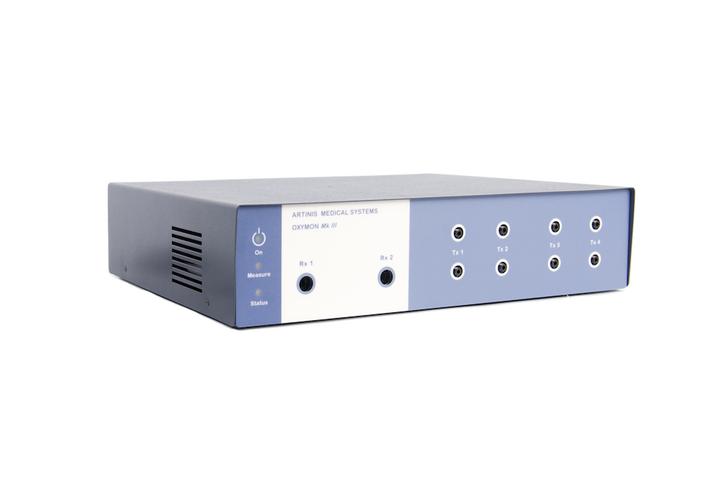
Publications using the OxyMon
Changes in cerebral oxygenation during parabolic flight
Assessing changes in brain activity under extreme conditions like weightlessness is a desirable, but difficult undertaking. Results from previous studies report specific changes in brain activity connected to an increase or decrease in gravity …
Middle cerebral O2 delivery during the modified Oxford maneuver increases with sodium nitroprusside and decreases during phenylephrine
The modified Oxford maneuver is the reference standard for assessing arterial baroreflex function. The maneuver comprises a systemic bolus injection of 100 $μ$g sodium nitroprusside (SNP) followed by 150 $μ$g phenylephrine (PE). On the one hand, this …
The relationship between brain cortical activity and brain oxygenation in the prefrontal cortex during hypergravity exposure
Artificial gravity has been proposed as a method to counteract the physiological deconditioning of long-duration spaceflight; however, the effects of hypergravity on the central nervous system has had little study. The study aims investigate whether …
Impaired cerebral haemodynamic function associated with chronic traumatic brain injury in professional boxers
The present study examined to what extent professional boxing compromises cerebral haemodynamic function and its association with CTBI (chronic traumatic brain injury). A total of 12 male professional boxers were compared with 12 age-, gender- and …
A comparison of exercise type and intensity on the noninvasive assessment of skeletal muscle mitochondrial function using near-infrared spectroscopy
In summary, NIRS measurements of mitochondrial function can be made with both VOL and ES exercises. The intensity of both ES and VOL exercises does not influence the measurement of the recovery of mVO2. The recovery of mVO2 after low- to …
Activity-induced changes in skeletal muscle metabolism measured with optical spectroscopy
PURPOSE: Previous studies have used near-infrared spectroscopy (NIRS) to measure skeletal muscle mitochondrial capacity. This study tested the hypothesis that NIRS-measured mitochondrial capacity would improve with endurance exercise training and …
Aerobic interval training improves oxygen uptake efficiency by enhancing cerebral and muscular hemodynamics in patients with heart failure
Background: Abnormal ventilatory/hemodynamic responses to exercise contribute to functional impairment in patients with heart failure (HF). This study investigates how interval and continuous exercise regimens influence functional capacity by …
Alveolar gas exchange, oxygen delivery and tissue deoxygenation in men and women during incremental exercise
We investigated whether leg and arm skeletal muscle, and cerebral deoxygenation, differ during incremental cycling exercise in men and women, and if women's lower capacity to deliver O2 affects tissue deoxygenation. Men (n=10) compared to women …
Articulation-based sound perception in verbal repetition: A functional NIRS study
Verbal repetition is a fundamental language capacity where listening and speaking are inextricably coupled with each other. We have recently reported that the left inferior frontal gyrus (IFG) harbors articulation-based codes, as evidenced by …
Calf muscle stimulation with the Veinoplus device results in a significant increase in lower limb inflow without generating limb ischemia or pain in patients with peripheral artery disease
Objective: Increase in arterial inflow to the lower limbs is important to obtain functional improvement in peripheral artery disease (PAD) patients with claudication. The aim of this study was to assess the effect of electrical stimulation of calf …
Case report: Endurance electrical stimulation training improves skeletal muscle oxidative capacity in chronic spinal cord injury
Objective To describe the use of a novel neuromuscular electrical stimulation (NMES) endurance exercise protocol and its effects on skeletal muscle oxidative capacity. Design Case report, pre/post intervention. Setting University-based trial. …
Faster pulmonary oxygen uptake kinetics in children vs adults due to enhancements in oxygen delivery and extraction
This study aimed to examine if the faster pulmonary oxygen uptake (VO2p) phase 2 in children could be explained by increased O 2 availability or extraction at the muscle level. For that purpose, O 2 availability and extraction were assessed using …
Firefighters muscular recovery after a heavy work bout in the heat
Occasionally firefighters need to perform very heavy bouts of work, such as smoke diving or clearing an accident site, which induce significant muscle fatigue. The time span for muscular recovery from such heavy work is not known. The purpose of this …
Fusion of fNIRS and fMRI data: Identifying when and where hemodynamic signals are changing in human brains
In this study we implemented a new imaging method to fuse functional near infrared spectroscopy (fNIRS) measurements and functional magnetic resonance imaging (fMRI) data to reveal the spatiotemporal dynamics of the hemodynamic responses with high …
Investigation of frontal lobe activation with fNIRS and systemic changes during video gaming
Frontal lobe activation caused by tasks such as videogames can be investigated using multichannel near-infrared spectroscopy (fNIRS), sometimes called optical topography. The aims of this study are to investigate the effects of video gaming (fighting …
Long-term enhancement of brain function and cognition using cognitive training and brain stimulation
Noninvasive brain stimulation has shown considerable promise for enhancing cognitive functions by the long-term manipulation of neuroplasticity [1-3]. However, the observation of such improvements has been focused at the behavioral level, and …
Multimodal integration of fNIRS, fMRI and EEG neuroimaging
Investigating human brain function can be improved byemploying a multimodal neuroimaging approach. The integrationof different non-invasive electrophysiological (e.g., electroenceph-alography-EEG and magnetoencephalography) and haemodynamic(e.g., …
Muscle, prefrontal, and motor cortex oxygenation profiles during prolonged fatiguing exercise
This study aimed to compare changes in skeletal muscle, prefrontal (PFC), and motor (MC) cortex hemodynamics during prolonged (i.e., 4-h) fatiguing whole-body exercise using multichannel near-infrared spectroscopy (NIRS). Ten subjects completed three …
Music improves verbal memory encoding while decreasing prefrontal cortex activity: An fNIRS study
Listening to music engages the whole brain, thus stimulating cognitive performance in a range of non-purely musical activities such as language and memory tasks. This article addresses an ongoing debate on the link between music and memory for words. …
Near-infrared spectroscopy during exercise and recovery in children with juvenile dermatomyositis
Introduction: We hypothesized that microvascular disturbances in muscle tissue play a role in the reduced exercise capacity in juvenile dermatomyositis (JDM). Methods: Children with JDM, children with juvenile idiopathic arthritis (clinical …